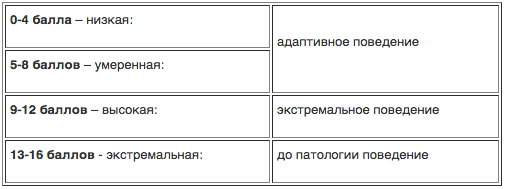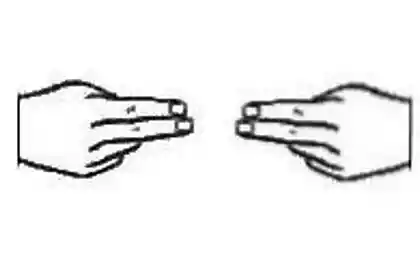958
Test Leary — find out the TRUTH about himself
A description of the methodology
This method was developed by Timothy Leary (1954) and is designed to study the representations of the subject about themselves and the ideal self, and to study the relationship in small groups. With it revealed the predominant type of attitude towards people in self-assessment and mutual evaluation. At the same time revealed two factors: "dominance-submission" and "friendliness-aggression (hostility)".
These factors determine the overall impression of the person in the processes of interpersonal perception.

Timothy Leary
Depending on the relevant indicators highlighted a number of attitudes — types of attitudes. Conclusions about the severity type, the adaptability of behavior — the degree of conformity (discrepancy) between goals and achieved in the process of activity results.
A very large noadaptive behavior (in the presentation of results is highlighted in red) may indicate a neurotic abnormalities, disharmony in decision-making or result from any extreme situations.
The technique can be used for self-assessment and assessment of the observed behaviour of people ("parties"). In the latter case, the subject answers questions as if for another person, based on your perception of it.
Summarizing the test results of the different group members (e.g., work team), it is possible to make a generalized "attitudinal" portrait of any of its members, for example, leader. And draw conclusions about the attitude of other members of the group.
Theoretical foundations
The method created by T. Leary, G. Laforge, R. Casecom in 1954 andis designed to study the representations of the subject about themselves and the ideal self, and to study the relationship in small groups. With the help of this technique revealed the predominant type of attitude towards people in self-assessment and mutual evaluation.
In the study of interpersonal relationships are most often distinguished by two factors: dominance-submission and friendliness-aggressiveness. These factors determine the overall impression of the person in the processes of interpersonal perception.
They are called M. Argila among the main components in the analysis of the style of interpersonal behavior and content can be correlated with two of the three principal axes of Charles Osgood's semantic differential: evaluation and power.
In the multi-year study conducted by American psychologists, under the leadership of B. Bales, the behavior of the member of the group is measured by two variables, the analysis of which is carried out in three-dimensional space formed by three axes: dominance-submission, friendliness-aggressiveness, emotional and analytic.

To represent the main social orientations of T. Leary developed a conditional model in the form of a circle divided into sectors. In this circle along the horizontal and vertical axes , the four designated orientation: dominance-submission, friendliness-hostility. In turn, these sectors are divided into eight respectively, more private relationships. For more subtle descriptions of a circle divided into 16 sectors, but often used octants in a certain way oriented relative to the two main axes.
Scheme T. Leary based on the assumption that the closer are the results of the test to the center of the circle, the stronger the relationship between these two variables. The amount of points each orientation is translated into an index, which is dominated by a vertical (dominance-subordination) and horizontal (friendliness-hostility) axis. Distance indicators obtained from the center of the circle indicates the adaptability or extreme interpersonal behavior.
The questionnaire contains 128 value judgments, of which in each of the 8 types of relationships are formed 16 points, ordered by ascending intensity. The method is constructed so that the judgment to clarify any type of relationship, are not consecutive, and in a special way: they are grouped by 4 and is repeated after equal number of definitions. In the processing counts the number of relations of each type.
T. Leary proposed the use of a methodology to assess the observed behavior, i.e. behavior in the evaluation of others ("from"), self-assessment, evaluation close people to describe the ideal "I". In accordance with these levels changing diagnostic manual for the answer. Different areas of diagnostics allow to determine the type of personality, and also to compare data on certain aspects. For example, the "social "I", "real self", "my partners," etc.
Procedure
Manual
"You will be presented with judgments concerning the nature of man, his relationships with other people. Carefully read each judgment and evaluate if it matches Your idea of yourself.
Put on the form answers the " + "sign against the numbers of those definitions that fit Your picture of yourself, and the" – " sign against the numbers of those claims that do not conform to Your idea of yourself. Try to be sincere. If there is no confidence, a sign " + " is not set.
After assessing his real "I" re-read all the judgement and mark those that fit Your idea of what You, in Your opinion, would be ideal."
If you want to assess the personality of someone else, then given an additional instruction: "in the same way as in the first two variants, assess the personality of Your boss (colleague, subordinate: 1. "My head, is what he is actually"; 2. "My ideal boss").
The technique can be presented to the Respondent either as a list (alphabetically or randomly), or on a separate card. It is invited to specify those claims that fit his conception of himself, belong to another person or ideal.
Processing of the results
In the first stage of data processing is the calculation of the score for each octant using the key to the questionnaire.
Key
Authoritarian: 1 – 4, 33 – 36, 65 – 68, 97 – 100. Selfish: 5 – 8, 37 – 40, 69 – 72, 101 – 104. Aggressive: 9 – 12, 41 – 44, 73 – 76, 105 – 108. Suspicious: 13 – 16, 45 – 48, 77 – 80, 109 – 112. Submit: 17 – 20, 49 – 52, 81 – 84, 113 – 116. Dependent: 21 – 24, 53 – 56, 85 – 88, 117 – 120. Friendly: 25 – 28, 57 – 60, 89 – 92, 121 – 124. Altruistic: 29 – 32, 61 – 64, 93 – 96, 125 – 128. In the second stage, the obtained credits are transferred to the diagram, the distance from the center of the circle corresponds to the number of points in this octant (the minimum is 0, maximum is 16).
The ends of the vectors are connected to form a profile that reflects the concept of the personality of the person. Delineated space zastrahovatsja. For each view a separate graph is constructed, where it is characterized by signs of each of the octants.
The mental graph

In the third stage, using formulas determined by performance on two main parameters "Dominance" and "Friendliness":
Dominance = (I – V) + 0.7 x (VIII + II – IV – VI)
Friendliness = (VII – III) + 0.7 x (VIII – II – IV + VI)
Thus, the scoring system for 16 interpersonal variables into two digital index, which characterize the view of the subject at the indicated parameters.
As a result, an analysis of the personal profile identifies the types of attitudes.
Interpretation of results
The calculation of points is conducted separately for each of the evaluated individual. Indicator of impairment of the relationship with a specific person is the difference between the ideas of man about him, and desired his image as a partner in communication.
The maximum assessment level is 16 points, but it is divided into four degrees of severity of relationship:

A positive value of the result obtained according to the formula of "domination", shows a pronounced aspiration to leadership in communication, to dominate. A negative value indicates a tendency to obedience, an abdication of responsibility and positions of leadership.
A positive result according to the formula "friendliness" is an indicator of the desire of the individual to the establishment of friendly relations and cooperation with others. A negative result indicates that the expression of aggressive-competitive position that prevents cooperation and successful joint activities. Quantitative results are indicators of the severity of these characteristics.
The most shaded on the profile of the octants correspond to the prevalent style of interpersonal relations of the individual. Specifications, not exceeding 8 points, characteristic of harmonious personalities. These are higher than 8 points reveal the accentuation of the properties identified by the octant.
Points, reaching the level of 14-16, attest to the difficulties of social adaptation. Low rates for all octants (0-3 points) can be the result of secrecy and lack of candor of the subject. If the mental graph no octants, shaded above 4 points, then the data is questionable in terms of their authenticity: the situation of diagnosis was not disposed to frankness.
The first four types of interpersonal relationships (octants 1 to 4) tend to leadership and dominance, independence of opinion, readiness to defend own point of view in the conflict. The other four octant (5-8) – represent the prevalence of conformal installations, self-doubt, give the opinion of others, a tendency to compromise.
In General, the interpretation of data should focus on the prevalence of some indicators over others and, to a lesser extent on absolute values. Normal is usually not significant variations between the "I" the actual and the ideal. A moderate difference can be seen as a necessary condition for self-improvement.
Dissatisfaction is more common in individuals with low self-esteem (5,6,7 octants), as well as persons in situations of protracted conflict (4 octant). At the same time the predominance of 1 and 5 oktant characteristic of persons with the problem of painful vanity, authoritarianism, 4 and 8 – the conflict between the desire for acceptance and group hostility, i.e. the problem of suppressed hostility, 3 and 7 –the struggle of motives of self-affirmation and affiliation, 2 and 6 – the problem of independence of podchinyalas that arise in complex service situations, are forced to obey despite internal protest.
Of the individual, which are found dominant, aggressive and independent behaviors, much less complain his character and interpersonal relations, however, they may reveal a tendency to improvement in their style of interpersonal interaction with the environment. This increase of indicators of a oktant will determine the direction in which they move independently of the personality for self-improvement, awareness of the existing problems, the presence of intrapersonal resources.

Types of interpersonal relationships
I. Authoritarian
13 — 16 – dictatorial, imperious, despotic nature, a type of strong personality, which leads to all kinds of group activities. All edifies, all over seeks to rely on his mind, not able to accept the advice of others. People keep commenting on this authority, but recognize it.
9 — 12 – dominant, energetic, competent, authoritative leader, successful in business, loves to give advice, demands the respect. 0-8 – confident person, but not necessarily a leader, persistent.
II. Selfish
13 — 16 , aims to be above all, but also aloof, narcissistic, calculating, independent, selfish. Difficulties shifts on others, he refers to him somewhat aloof, boastful, smug, arrogant.
0 — 12 – selfish traits, focus on yourself, the propensity to rivalry.
III. Aggressive
13 — 16 – tight and hostile towards others, sharp, hard, aggressive can reach up to antisocial behaviour.
9 — 12 –demanding, straightforward, Frank, is strict and sharp in the evaluation of other, implacable, inclined to blame all others, mocking, ironic, irritable.
0 — 8 – obstinate, stubborn, persistent and energetic.
IV. Suspicious
13 — 16 is alienated in relation to the hostile and vicious world, suspicious, touchy, prone to doubt everything, vindictive, continuously complaining, at all, unhappy with all (schizoid type).
9 — 12 – critical, uncommunicative, difficulties in interpersonal contact because of insecurity, suspicion and fear of the bad attitude, antisocial, skeptical, disappointed in people, secretive, your negativity manifests in verbal aggression.
0 — 8 – critical in relation to all social phenomena, and to others.
V. Submit
13 — 16 – submissive, prone to self-humiliation, weak-willed, tend to give everyone and everything, always puts himself in last place and condemns himself, ascribes to himself the blame, passive, seeks to find support in someone stronger.
9 — 12 –shy, meek, easily embarrassed, prone to obey more powerful without considering the situation.
0 — 8 – modest, timid, compliant, emotionally restrained, able to obey, has no own opinion, obeys and honestly perform their duties.
VI. Dependent
13 — 16 – dramatically insecure, has obsessive fears, concerns, worries on any occasion, therefore, dependent on others, from other people's opinions. 9-12 – obedient, fearful, helpless, not able to show resistance, sincerely believes that others are always right.
0 — 8 – conformal, soft, expects help and advice, trusting, prone to admiration of others, polite.
VII. Friendly
9 — 16 – friendly and kind to everyone, focused on acceptance and social approval, striving to meet the needs of all, "being good" for all, without regard to the situation, committed to the goals of micro-group, has developed mechanisms of repression and suppression, emotional lability (hysteroid character type).
0 — 8 – cooperative, cooperation, flexible and compromise when solving problems and conflict situations, striving to be in accord with the opinions of others, consciously conformal, it follows the conventions, rules and principles of "good tone" in relations with people, enthusiastic enthusiast in the achievement of group objectives and strives to help feel the center of attention, to earn respect and love, sociable, shows warmth and friendliness in relations.
VIII. Altruistic
9 — 16 – giperatidnyi, always sacrificing their own interests, seeks to help and sympathize with everything, obsessive in his care and very active in relation to others, takes responsibility for others (may be only an external mask that hides the identity of the opposite type).
0 — 8 – responsive to the people, delicate, soft, kind, emotional attitude to people showing compassion, sympathy, care, affection, able to encourage and reassure others, unselfish.
The first four types of interpersonal relationships -1, 2, 3 and 4 are characterized by a predominance of nonconformal tendencies and a penchant for disjunctive (conflicting) manifestations (3, 4), greater independence of opinion, tenacity in defending their own point of view, the tendency to leadership and dominance (1, 2).
The other four octant — 5, 6, 7 and 8 present the opposite pattern: the prevalence of conformal installations, congruence in contacts with others (7, 8), self-doubt, give the opinion of others, willingness to compromise (5, 6).
The text of the questionnaire
Instruction: You are offered a list of characteristics. You should carefully read each and decide whether it meets your idea of yourself. If match, then mark it in the Protocol with a cross, if there is no match, do not place anything. If there is no certainty that the cross is not put. Try to be sincere.
Others think of him favorably impress others is Able to dispose, order has her Has the dignity of an Independent Able to take care of themselves Can afford to be indifferent is Capable of being harsh, Strict, but fair Can be sincere Critical of others Likes to complain is Often sad is Able to show distrust Often disappointed Able to be critical of yourself is Able to admit they were wrong Willingly submits Compliant Grateful Admiration, tend to imitate Respectful Seeking approval is Able to cooperation, mutual assistance Strives to get along with other Friendly, benevolent, Attentive, Delicate gentle Reassuring Responsive to calls for assistance Unselfish is Capable to cause admiration Enjoyed by other respect Has a talent Manager Likes responsibility Confident, Cocky, assertive, Businesslike, practical, Likes to compete Persistent and stubborn, where you have the Inexorable but impartial Irritable Sociable, straightforward does Not tolerate to be commanded Skeptical On it's hard to impress Touchy, sensitive Easily embarrassed, Insecure Compliant Modest Often resorts to the help of other Very honors the authority is Willing to accept advice Trusting and aims to please others is Always helpful in the treatment of Values the opinions of others, Sociable, good-natured good-Hearted Kind, instills confidence and a Gentle, soft-hearted Likes to take care of others, Unselfish, generous, Loves to give advice to the impression of a significant person Overbearing Domineering imperious Arrogant Boastful and self-righteous Thinks only of himself Cunning, calculating, Intolerant of mistakes of others is Selfish Often Outright hostile Bitter Jealous Appellant for a Long time remember their grievances Samebecause Meek, Shy, Passive, Dependent, dependent and Loves to obey Gives others to make decisions Easily falls into the trap Easily influenced friends Ready to trust any Favour to all without discrimination All sympathetic Forgives all Crowded with excessive sympathy is Generous, we suffer the disadvantages is Committed to protect Committed to the success of Expecting admiration from each other to Dispose a Tyrannical Snob that judges people only by rank and wealth in a Vain, Selfish, Cold, callous, Sarcastic, mocking, Evil, violent Often angry, Insensitive, indifferent, Vindictive Imbued with the spirit of contradiction Stubborn, Distrustful, suspicious, Timid Shy Differ excessive willingness to obey Spineless Almost never object to Obsessive Love, to care Overly trusting Tends to find the location of each agrees With all the Always friendly Loves all Too lenient to others Tries to comfort everyone Cares about others to the detriment of itself Corrupts people excessive kindness.published by P. S. And remember, just changing your mind — together we change the world! ©
Source: www.psychologos.ru/articles/view/test_mezhlichnostnyh_otnosheniy_liri
This method was developed by Timothy Leary (1954) and is designed to study the representations of the subject about themselves and the ideal self, and to study the relationship in small groups. With it revealed the predominant type of attitude towards people in self-assessment and mutual evaluation. At the same time revealed two factors: "dominance-submission" and "friendliness-aggression (hostility)".
These factors determine the overall impression of the person in the processes of interpersonal perception.

Timothy Leary
Depending on the relevant indicators highlighted a number of attitudes — types of attitudes. Conclusions about the severity type, the adaptability of behavior — the degree of conformity (discrepancy) between goals and achieved in the process of activity results.
A very large noadaptive behavior (in the presentation of results is highlighted in red) may indicate a neurotic abnormalities, disharmony in decision-making or result from any extreme situations.
The technique can be used for self-assessment and assessment of the observed behaviour of people ("parties"). In the latter case, the subject answers questions as if for another person, based on your perception of it.
Summarizing the test results of the different group members (e.g., work team), it is possible to make a generalized "attitudinal" portrait of any of its members, for example, leader. And draw conclusions about the attitude of other members of the group.
Theoretical foundations
The method created by T. Leary, G. Laforge, R. Casecom in 1954 andis designed to study the representations of the subject about themselves and the ideal self, and to study the relationship in small groups. With the help of this technique revealed the predominant type of attitude towards people in self-assessment and mutual evaluation.
In the study of interpersonal relationships are most often distinguished by two factors: dominance-submission and friendliness-aggressiveness. These factors determine the overall impression of the person in the processes of interpersonal perception.
They are called M. Argila among the main components in the analysis of the style of interpersonal behavior and content can be correlated with two of the three principal axes of Charles Osgood's semantic differential: evaluation and power.
In the multi-year study conducted by American psychologists, under the leadership of B. Bales, the behavior of the member of the group is measured by two variables, the analysis of which is carried out in three-dimensional space formed by three axes: dominance-submission, friendliness-aggressiveness, emotional and analytic.

To represent the main social orientations of T. Leary developed a conditional model in the form of a circle divided into sectors. In this circle along the horizontal and vertical axes , the four designated orientation: dominance-submission, friendliness-hostility. In turn, these sectors are divided into eight respectively, more private relationships. For more subtle descriptions of a circle divided into 16 sectors, but often used octants in a certain way oriented relative to the two main axes.
Scheme T. Leary based on the assumption that the closer are the results of the test to the center of the circle, the stronger the relationship between these two variables. The amount of points each orientation is translated into an index, which is dominated by a vertical (dominance-subordination) and horizontal (friendliness-hostility) axis. Distance indicators obtained from the center of the circle indicates the adaptability or extreme interpersonal behavior.
The questionnaire contains 128 value judgments, of which in each of the 8 types of relationships are formed 16 points, ordered by ascending intensity. The method is constructed so that the judgment to clarify any type of relationship, are not consecutive, and in a special way: they are grouped by 4 and is repeated after equal number of definitions. In the processing counts the number of relations of each type.
T. Leary proposed the use of a methodology to assess the observed behavior, i.e. behavior in the evaluation of others ("from"), self-assessment, evaluation close people to describe the ideal "I". In accordance with these levels changing diagnostic manual for the answer. Different areas of diagnostics allow to determine the type of personality, and also to compare data on certain aspects. For example, the "social "I", "real self", "my partners," etc.
Procedure
Manual
"You will be presented with judgments concerning the nature of man, his relationships with other people. Carefully read each judgment and evaluate if it matches Your idea of yourself.
Put on the form answers the " + "sign against the numbers of those definitions that fit Your picture of yourself, and the" – " sign against the numbers of those claims that do not conform to Your idea of yourself. Try to be sincere. If there is no confidence, a sign " + " is not set.
After assessing his real "I" re-read all the judgement and mark those that fit Your idea of what You, in Your opinion, would be ideal."
If you want to assess the personality of someone else, then given an additional instruction: "in the same way as in the first two variants, assess the personality of Your boss (colleague, subordinate: 1. "My head, is what he is actually"; 2. "My ideal boss").
The technique can be presented to the Respondent either as a list (alphabetically or randomly), or on a separate card. It is invited to specify those claims that fit his conception of himself, belong to another person or ideal.
Processing of the results
In the first stage of data processing is the calculation of the score for each octant using the key to the questionnaire.
Key
Authoritarian: 1 – 4, 33 – 36, 65 – 68, 97 – 100. Selfish: 5 – 8, 37 – 40, 69 – 72, 101 – 104. Aggressive: 9 – 12, 41 – 44, 73 – 76, 105 – 108. Suspicious: 13 – 16, 45 – 48, 77 – 80, 109 – 112. Submit: 17 – 20, 49 – 52, 81 – 84, 113 – 116. Dependent: 21 – 24, 53 – 56, 85 – 88, 117 – 120. Friendly: 25 – 28, 57 – 60, 89 – 92, 121 – 124. Altruistic: 29 – 32, 61 – 64, 93 – 96, 125 – 128. In the second stage, the obtained credits are transferred to the diagram, the distance from the center of the circle corresponds to the number of points in this octant (the minimum is 0, maximum is 16).
The ends of the vectors are connected to form a profile that reflects the concept of the personality of the person. Delineated space zastrahovatsja. For each view a separate graph is constructed, where it is characterized by signs of each of the octants.
The mental graph

In the third stage, using formulas determined by performance on two main parameters "Dominance" and "Friendliness":
Dominance = (I – V) + 0.7 x (VIII + II – IV – VI)
Friendliness = (VII – III) + 0.7 x (VIII – II – IV + VI)
Thus, the scoring system for 16 interpersonal variables into two digital index, which characterize the view of the subject at the indicated parameters.
As a result, an analysis of the personal profile identifies the types of attitudes.
Interpretation of results
The calculation of points is conducted separately for each of the evaluated individual. Indicator of impairment of the relationship with a specific person is the difference between the ideas of man about him, and desired his image as a partner in communication.
The maximum assessment level is 16 points, but it is divided into four degrees of severity of relationship:

A positive value of the result obtained according to the formula of "domination", shows a pronounced aspiration to leadership in communication, to dominate. A negative value indicates a tendency to obedience, an abdication of responsibility and positions of leadership.
A positive result according to the formula "friendliness" is an indicator of the desire of the individual to the establishment of friendly relations and cooperation with others. A negative result indicates that the expression of aggressive-competitive position that prevents cooperation and successful joint activities. Quantitative results are indicators of the severity of these characteristics.
The most shaded on the profile of the octants correspond to the prevalent style of interpersonal relations of the individual. Specifications, not exceeding 8 points, characteristic of harmonious personalities. These are higher than 8 points reveal the accentuation of the properties identified by the octant.
Points, reaching the level of 14-16, attest to the difficulties of social adaptation. Low rates for all octants (0-3 points) can be the result of secrecy and lack of candor of the subject. If the mental graph no octants, shaded above 4 points, then the data is questionable in terms of their authenticity: the situation of diagnosis was not disposed to frankness.
The first four types of interpersonal relationships (octants 1 to 4) tend to leadership and dominance, independence of opinion, readiness to defend own point of view in the conflict. The other four octant (5-8) – represent the prevalence of conformal installations, self-doubt, give the opinion of others, a tendency to compromise.
In General, the interpretation of data should focus on the prevalence of some indicators over others and, to a lesser extent on absolute values. Normal is usually not significant variations between the "I" the actual and the ideal. A moderate difference can be seen as a necessary condition for self-improvement.
Dissatisfaction is more common in individuals with low self-esteem (5,6,7 octants), as well as persons in situations of protracted conflict (4 octant). At the same time the predominance of 1 and 5 oktant characteristic of persons with the problem of painful vanity, authoritarianism, 4 and 8 – the conflict between the desire for acceptance and group hostility, i.e. the problem of suppressed hostility, 3 and 7 –the struggle of motives of self-affirmation and affiliation, 2 and 6 – the problem of independence of podchinyalas that arise in complex service situations, are forced to obey despite internal protest.
Of the individual, which are found dominant, aggressive and independent behaviors, much less complain his character and interpersonal relations, however, they may reveal a tendency to improvement in their style of interpersonal interaction with the environment. This increase of indicators of a oktant will determine the direction in which they move independently of the personality for self-improvement, awareness of the existing problems, the presence of intrapersonal resources.

Types of interpersonal relationships
I. Authoritarian
13 — 16 – dictatorial, imperious, despotic nature, a type of strong personality, which leads to all kinds of group activities. All edifies, all over seeks to rely on his mind, not able to accept the advice of others. People keep commenting on this authority, but recognize it.
9 — 12 – dominant, energetic, competent, authoritative leader, successful in business, loves to give advice, demands the respect. 0-8 – confident person, but not necessarily a leader, persistent.
II. Selfish
13 — 16 , aims to be above all, but also aloof, narcissistic, calculating, independent, selfish. Difficulties shifts on others, he refers to him somewhat aloof, boastful, smug, arrogant.
0 — 12 – selfish traits, focus on yourself, the propensity to rivalry.
III. Aggressive
13 — 16 – tight and hostile towards others, sharp, hard, aggressive can reach up to antisocial behaviour.
9 — 12 –demanding, straightforward, Frank, is strict and sharp in the evaluation of other, implacable, inclined to blame all others, mocking, ironic, irritable.
0 — 8 – obstinate, stubborn, persistent and energetic.
IV. Suspicious
13 — 16 is alienated in relation to the hostile and vicious world, suspicious, touchy, prone to doubt everything, vindictive, continuously complaining, at all, unhappy with all (schizoid type).
9 — 12 – critical, uncommunicative, difficulties in interpersonal contact because of insecurity, suspicion and fear of the bad attitude, antisocial, skeptical, disappointed in people, secretive, your negativity manifests in verbal aggression.
0 — 8 – critical in relation to all social phenomena, and to others.
V. Submit
13 — 16 – submissive, prone to self-humiliation, weak-willed, tend to give everyone and everything, always puts himself in last place and condemns himself, ascribes to himself the blame, passive, seeks to find support in someone stronger.
9 — 12 –shy, meek, easily embarrassed, prone to obey more powerful without considering the situation.
0 — 8 – modest, timid, compliant, emotionally restrained, able to obey, has no own opinion, obeys and honestly perform their duties.
VI. Dependent
13 — 16 – dramatically insecure, has obsessive fears, concerns, worries on any occasion, therefore, dependent on others, from other people's opinions. 9-12 – obedient, fearful, helpless, not able to show resistance, sincerely believes that others are always right.
0 — 8 – conformal, soft, expects help and advice, trusting, prone to admiration of others, polite.
VII. Friendly
9 — 16 – friendly and kind to everyone, focused on acceptance and social approval, striving to meet the needs of all, "being good" for all, without regard to the situation, committed to the goals of micro-group, has developed mechanisms of repression and suppression, emotional lability (hysteroid character type).
0 — 8 – cooperative, cooperation, flexible and compromise when solving problems and conflict situations, striving to be in accord with the opinions of others, consciously conformal, it follows the conventions, rules and principles of "good tone" in relations with people, enthusiastic enthusiast in the achievement of group objectives and strives to help feel the center of attention, to earn respect and love, sociable, shows warmth and friendliness in relations.
VIII. Altruistic
9 — 16 – giperatidnyi, always sacrificing their own interests, seeks to help and sympathize with everything, obsessive in his care and very active in relation to others, takes responsibility for others (may be only an external mask that hides the identity of the opposite type).
0 — 8 – responsive to the people, delicate, soft, kind, emotional attitude to people showing compassion, sympathy, care, affection, able to encourage and reassure others, unselfish.
The first four types of interpersonal relationships -1, 2, 3 and 4 are characterized by a predominance of nonconformal tendencies and a penchant for disjunctive (conflicting) manifestations (3, 4), greater independence of opinion, tenacity in defending their own point of view, the tendency to leadership and dominance (1, 2).
The other four octant — 5, 6, 7 and 8 present the opposite pattern: the prevalence of conformal installations, congruence in contacts with others (7, 8), self-doubt, give the opinion of others, willingness to compromise (5, 6).
The text of the questionnaire
Instruction: You are offered a list of characteristics. You should carefully read each and decide whether it meets your idea of yourself. If match, then mark it in the Protocol with a cross, if there is no match, do not place anything. If there is no certainty that the cross is not put. Try to be sincere.
Others think of him favorably impress others is Able to dispose, order has her Has the dignity of an Independent Able to take care of themselves Can afford to be indifferent is Capable of being harsh, Strict, but fair Can be sincere Critical of others Likes to complain is Often sad is Able to show distrust Often disappointed Able to be critical of yourself is Able to admit they were wrong Willingly submits Compliant Grateful Admiration, tend to imitate Respectful Seeking approval is Able to cooperation, mutual assistance Strives to get along with other Friendly, benevolent, Attentive, Delicate gentle Reassuring Responsive to calls for assistance Unselfish is Capable to cause admiration Enjoyed by other respect Has a talent Manager Likes responsibility Confident, Cocky, assertive, Businesslike, practical, Likes to compete Persistent and stubborn, where you have the Inexorable but impartial Irritable Sociable, straightforward does Not tolerate to be commanded Skeptical On it's hard to impress Touchy, sensitive Easily embarrassed, Insecure Compliant Modest Often resorts to the help of other Very honors the authority is Willing to accept advice Trusting and aims to please others is Always helpful in the treatment of Values the opinions of others, Sociable, good-natured good-Hearted Kind, instills confidence and a Gentle, soft-hearted Likes to take care of others, Unselfish, generous, Loves to give advice to the impression of a significant person Overbearing Domineering imperious Arrogant Boastful and self-righteous Thinks only of himself Cunning, calculating, Intolerant of mistakes of others is Selfish Often Outright hostile Bitter Jealous Appellant for a Long time remember their grievances Samebecause Meek, Shy, Passive, Dependent, dependent and Loves to obey Gives others to make decisions Easily falls into the trap Easily influenced friends Ready to trust any Favour to all without discrimination All sympathetic Forgives all Crowded with excessive sympathy is Generous, we suffer the disadvantages is Committed to protect Committed to the success of Expecting admiration from each other to Dispose a Tyrannical Snob that judges people only by rank and wealth in a Vain, Selfish, Cold, callous, Sarcastic, mocking, Evil, violent Often angry, Insensitive, indifferent, Vindictive Imbued with the spirit of contradiction Stubborn, Distrustful, suspicious, Timid Shy Differ excessive willingness to obey Spineless Almost never object to Obsessive Love, to care Overly trusting Tends to find the location of each agrees With all the Always friendly Loves all Too lenient to others Tries to comfort everyone Cares about others to the detriment of itself Corrupts people excessive kindness.published by P. S. And remember, just changing your mind — together we change the world! ©
Source: www.psychologos.ru/articles/view/test_mezhlichnostnyh_otnosheniy_liri
Ultrasound: voluntary paid mutation - payback in 15-20 years
Digestive system — the mirror of nature and experienced stress























